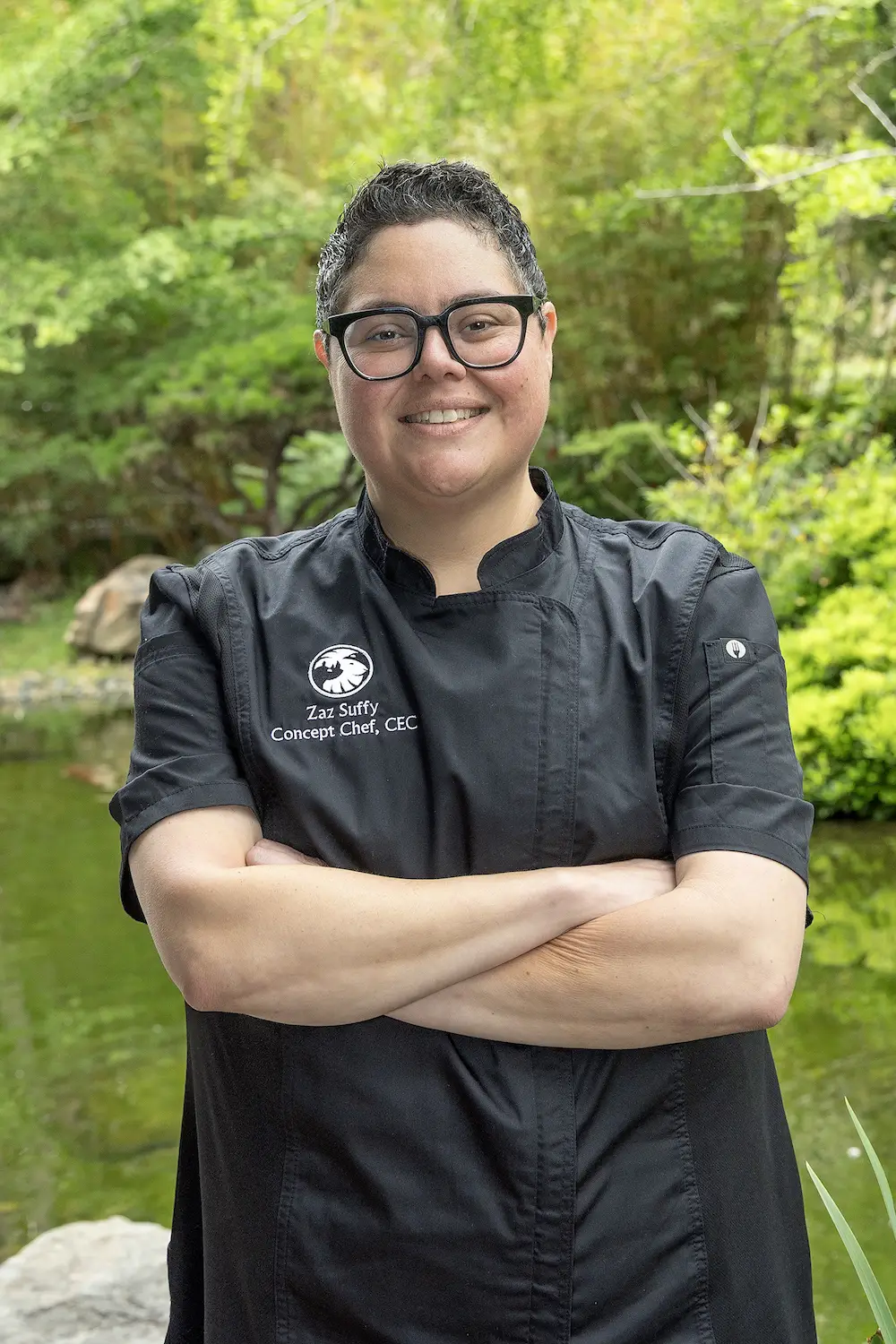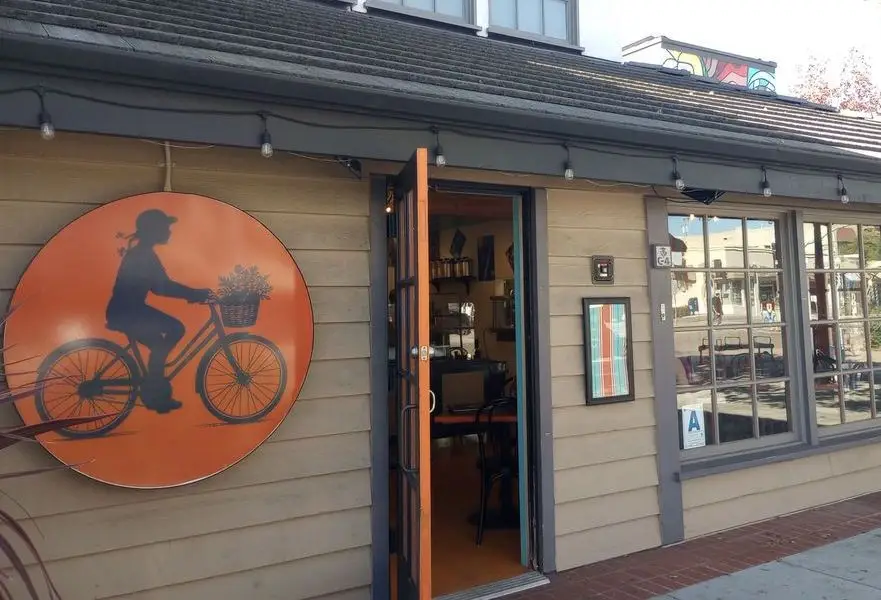“I did a Wagyu dinner where I made edible candles out of Wagyu tallow, and then we pre-lit them so they would be nice and soupy already. Then we put a little bit of Temecula olive oil, balsamic vinegar, and that was their first bread course—they had to dip the little demi baguette in there.”
This wasn’t a hip pop-up pulling out all the stops. Not a cult-loved bistro. It was the San Diego Zoo.
Yes, the Zoo has a chef—executive concept chef, Zaz Suffy—who’s responsible for a couple things. Special dinners like this are part of it. A from-scratch pastry operation serving over four million people a year is another.
“Being able to come up with these whimsical things at the end of the day, it makes me so happy,” says Suffy, recalling a vegan course she once made to mimic duck confit, complete with “bones” made of jicama. “Yeah, we do millions of burgers and hot dogs, which I’m very proud of. But at the end of the day, we also do Wagyu dinners. We do pairings with bourbon dinners. We do all sorts of custom menus that I’m very proud of.”

Suffy oversees all 12 standalone restaurants and 17 kiosks at the zoo, plus events like weddings, corporate dinners, fundraising banquets, and festivals like San Diego Zoo Food, Wine & Brew. These can range from two-person dinners to guest lists in the thousands, as well as the unrelenting throng of zoo guests 365 days a year. Suffy estimates the zoo feeds around 25,000 people on a busy day. Executive chef Grant Toraason handles the day-to-day at the Safari Park, with Suffy coming in to pitch hit for big events when needed. Between the two parks, there’s a veritable food army. When I ask her how many, she ballparks it at a couple hundred.
A Tijuana and San Diego native, Suffy grew up coming to the zoo with her Mexican-Lebanese family who all loved to cook. She studied culinary arts at Grossmont College before moving to Le Cordon Bleu, specializing in baking and patisserie. She figured she’d end up on the sweet side of the kitchen before realizing that jobs-wise, there were more opportunities outside of pastries.
Her eye for climbing the chef ladder led her to cook at places like Dodger Stadium, Disneyland (twice), and USC until the pandemic brought her back home. She tried her hand at launching her own business, a cheese and charcuterie company, but quickly realized running a business by herself wasn’t her passion.

“I like having a team,” she explains, especially when it comes to post-service. “You always have to come back and wash everything yourself!”
So four years ago, when Suffy saw an opening for a banquet chef at the zoo, she jumped on it. On her first day on the job, the former executive chef went on medical leave. She found herself with an immediate promotion to acting executive chef.
Over time, the role has evolved. She doesn’t just make sure all the food carts and concepts run smoothly. She’s also in charge of adding new menu items every season (like soups and salads at Albert’s, the zoo’s sit-down restaurant), revamping outlet themes (she’s currently working on transforming Busy Bee Cafe into a smashburger concept), and launching brand new eateries (like Rex’s Donuts in the former San Diego Zoo Sandwich Co. suite, which she hopes will open later this year).

As she describes the idea behind Rex’s—which entails launching at least a dozen different donut flavors, plus a Mendocino Farms-inspired sandwich and fresh sides menu—she points to a display on the table near us piled with fluffy donuts coated with M&Ms, chocolate shavings, and of course, rainbow sprinkles. I sink my teeth into one smeared with pink frosting and sprinkles, and moan. It’s a remarkably fantastic donut—nothing like the stale, boxed ones from a grocery store or, frankly, what I’d expect from the zoo.
One you might expect from a pastry chef like Sussy.
The zoo’s dedicated confectionary team comes every day at 4 a.m. to make fresh donuts from scratch—plus, all the fudge, cookies, brownies, and a riff on homemade Pop-Tarts. As I find myself covered in crumbs and talking with a mouth full of glaze and happiness, Suffy tells me 100 percent of the sweet treats are made from scratch. Having proven herself over the last four years, she hopes to expand the in-house bakery to handle all of the bread across the zoo—as well as take on some of the desserts from the catering team.
“I want to grow it big,” she says.
It takes absolute laser focus to keep things running, come up with new ideas, and make sure every single one of the hundreds of team members is trained to see every detail in a high-volume environment. When your team has to make hundreds, if not thousands, of sandwiches from scratch day in and day out, balancing quality with simplicity is no easy task. Suffy might go through dozens of iterations before nailing it. But at the end of the day, it’s a job she calls a dream come true.
“Never did I ever think that I was going to work here,” she says. “But it’s been a blessing, and I want to be here for many more years.”
PARTNER CONTENT

Beth’s Bites
- First, some good news. AleSmith’s award-winning Speedway Stout comes in a variety of ridiculously decadent versions (think Peanut Butter Cup, German Chocolate Cake, and Vietnamese Coffee). Now, they’ve gone and done it, releasing a Stroopwafel edition to emulate everyone’s favorite Dutch waffle cookie. At 12 percent ABV, it still packs a boozy punch, but finishes with a sweet, creamy caramel and cinnamon flavor that is about as indulgent as a beer can get.
- Now, some bad news—Little Victory Wine Market closed its doors in Encinitas. On the bright side, their expanded Carlsbad location is still going strong, with goodies coming out of the kitchen from chefs Kelly and Elliott Townsend (Long Story Short) and plenty of wines to sip on-site or to take away.
- More good news! Michelin-recognized Mabel’s Gone Fishing has a whole slew of summertime fun planned in North Park, starting with $15 bodega sandwiches (noon to 2 p.m., Thursdays through Sundays while supplies last), plus a summer gin club, artist and winemaker dinners, and a bunch more. I didn’t need an excuse to go get a slice of Basque cheesecake, but now I have one, just in case.
- Okay, fine, one more bummer for San Diego food news this week. City Tacos’ East Village location is closing on June 30 due to the Padres purchasing the lease rights to the property, which sits adjacent to Petco Park’s Gaslamp gate. Owner Gerry Torres released a statement saying, “We were given minimal notice, but it’s hard to be too upset at our hometown team,” which (to me, at least) seems like the only way to reasonably take the news. None of City Tacos’ other locations are affected, and Torres teased a possible return to inside the ballpark, so here’s hoping that’s a compromise that works out for everybody.
Listen Now: The Latest in San Diego’s Food and Drink Scene
Have breaking news, exciting scoops, or great stories about new San Diego restaurants or the city’s food scene? Send your pitches to [email protected].




















